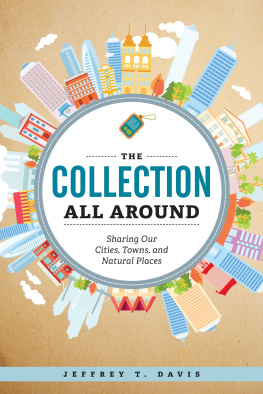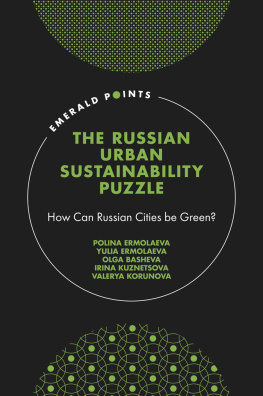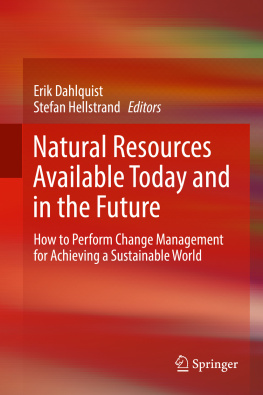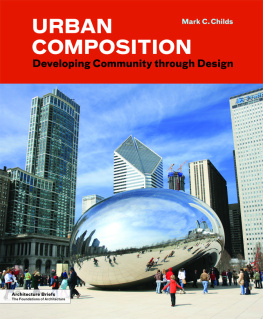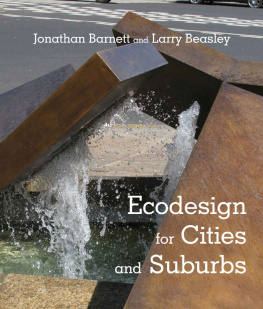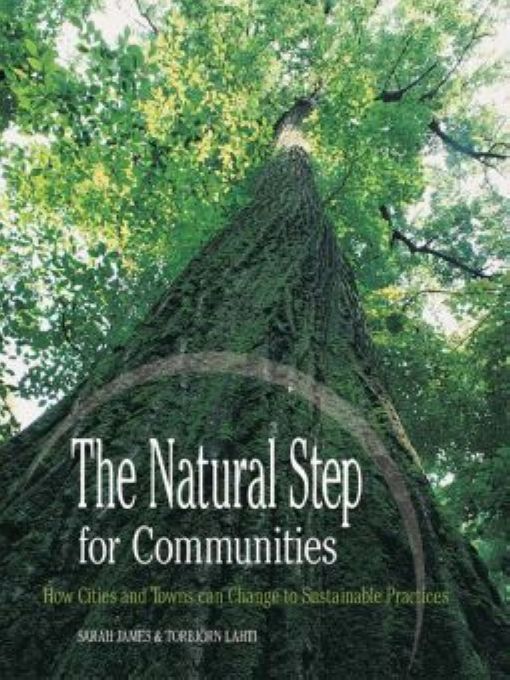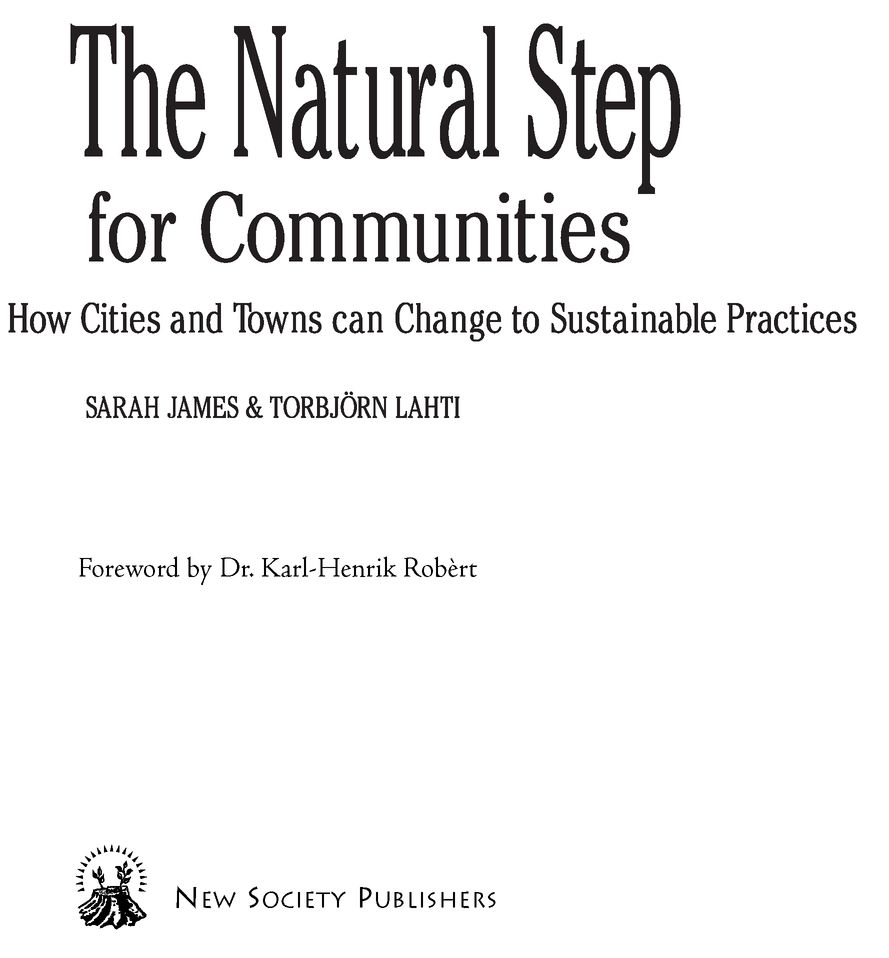Table of Contents
Advance Praise for
The Natural Step for Communities
As the signals of distress from our planet become increasingly shrill, the best hope for a sustainable future in the US lies in enlightened local leadership. The Natural Step for Communities illustrates, with clear and practical examples, what localities are able to accomplish from zip cars in Massachusetts, to organic farms in Philadelphia, to co-housing in Detroit to restoring clam beds off the coast of Maine. The book resonates with a critical understanding that any true sustainable grassroots revolution depends not just on innovation but also on a robust and vital democratic process. This book should be required reading for every mayor, town manager and city planner in the U.S.
Ross Gelbspan, author, The Heat Is On: The Climate Crisis, The Cover-up,The Prescription and Boiling Point
In Whistler, we use the Natural Step framework to bring clarity to the issue of sustainability. As we set out on the challenging course of applying the framework, it is encouraging to see The Natural Step for Communities a useful applications guide, complete with inspiring success stories from a growing network of progressive communities. I urge all elected local officials to read this book.
Mayor Hugh OReilly of Whistler
This is an important book for any community serious about the journey to sustainability. It lays out a rigorously conceived, comprehensive and tested methodology for sustainable community development. Its case studies breathe life into the sometimes esoteric sustainability discussion. I highly recommend it.
David Gershon, founder and architect of Global Action Plans award-winning EcoTeam Program, CEO of the Empowerment Institute and a leading expert on environmental behavior change
A wonderful and timely resource. Written as a fireside chat with Sarah and Torbjrn, this book should be required reading for everyone from elected members and chief executives to infrastructure managers and service delivery staff in city governments; it will provide them with a glimpse of what we all need to head toward. Our planet and society depend on it.
Eric Park, Sustainable Christchurch Leader, Christchurch City Council, New Zealand
The Natural Step for Communities is an extraordinarily readable volume that dispels the myth that sustainable community planning cannot be accomplished on a large and continuing scale. It challenges the reader by demonstrating the multitude of ways in which cities in North America and Europe are creating more environmentally secure futures. The book is written in a way that will allow its findings to be effectively communicated with decision makers, lay planners, and citizens. Our own community is exploring models for success that can be used to build such a community, and we will be keeping this volume by our side for inspiration.
Steven A. Preston, FAICP, Deputy City Manager/Community Development Director, San Gabriel, CA
The Natural Step for Communities provides us with a compelling and inspiring collection of success stories, clearly demonstrating that it is possible to achieve economic, ecological and social goals at the same time, and in many different and innovative ways. Congratulations to Sarah James and Tjorbrn Lahti for showing us how the Natural Step framework can empower community planners to design and create more sustainable communities. They give us hope that real change is possible in our lifetime. This book is a must read for anyone serious about moving his or her community toward sustainability.
Kelly Hawke Baxter, Chair, The Natural Step Canada
This book is a wonderful gift to all people working for sustainability both in municipalities and in companies. It is inspiring for those who have just started, and encouraging for those who have been struggling for many years on the front lines.
Sachiko Takami, Chief Executive, The Natural Step International, Japan office
The number of books (and databases) with good examples of sustainable development is multiplying rapidly. This book is not just another one. It does describe some interesting examples. But more importantly, it compares experience from three different networks and approaches, on three continents, and draws some tentative conclusions about success factors. The authors, both long-term practitioners, reflect on their own experience and that of others in the three networks, and distill their reflections into solid advice about project and process management.
Marilyn Mehlmann, General Secretary, Global Action Plan (GAP) International Steering Committee, Renaissance Europe
This book demystifies sustainability practices. The examples and accomplishments of the eco-municipalities in Sweden are surprisingly relevant to any municipalities in the United States willing to re-examine their unsustainable practices.
Terry Szold, Adjunct Associate Professor, Massachusetts Institute of Technology, Department of Urban Studies & Planning
Dedication
To the Findhorn community, where my journey to sustainability began.
Sarah James
To all the children those who are already born, and those who will be born.
Torbjrn Lahti
Acknowledgments
It is now clear to me that it takes a village to write a book. I want to thank my village, without whom this book could not have taken form.
To Janet Bush for her encouragement and advice about writing a book in the first place. To Jean Mason and Ted Allen for several months of reading, editing, and their many helpful suggestions. To Kim and Ileana Jones, Carolyn Revelle, and Maggie Carvan for their editing help. To Robin Harper for digitizing photos, document formating, editing, and hours of patient word-processing instruction to a sometimes-trying student. To Eva Tasaki for her many hours of Swedish to English translation and research. To Eric Park, my fellow Sustainable Sweden tour member, for his prodigious notes that allowed me to check the accuracy of mine and fill in some gaps. To the Swedish municipal staffers who answered our requests for information and those who welcomed, informed, and introduced us to the eco-accomplishments of their municipalities in August, 2001. To our publishers, Chris and Judith Plant, for their endorsement and support of this book project, and our editor, Judith Brand.
To my cohousing community for their company during the writing process. To my mother, Sarah Meyer, for her continual love and moral support.
To Philip B. Herr, who developed the Swamp Yankee planning approach described in this book. He has been my planning partner, colleague, teacher, advisor, and has contributed inestimably to my qualifications for co-writing this book.
To Karl-Henrik Robrt and the Natural Step framework, pivotal in my own sustainability paradigm shift. To the eco-municipalities of Sweden for all their accomplishments and for leading the way. And finally to my co-author, Torbjrn Lahti, who has been instrumental in the journeys of the eco-municipalities on the path to sustainability.
Sarah James
I have had the fortune to meet so many thousands of wonderful and competent people from all over the world. And each of them has given me so much and deserves my deepest gratitude, even if it is impossible to mention them all by name. Nevertheless, I must mention a few: To my dear friend and colleague, Gunnar Brundin, for our common struggle in winning and losing battles. Together we started Esam and become co-ordinators of the Swedish eco-municipality network. To all other co-workers at Esam, including Michael Jalmby, Vivi-Ann Adamsson, Barbro Kalla, Lasse Andersson, Oscar Lonconchino, Mikael Brndstrm, Susanne Eriksson, Sara Andersson, Erik Westerberg, and Ira Sundberg. To my colleagues in Robertsfors, including Bjrn Eriksson, Carina Aschan, Sren Borrelid, Hans Lindgren, and Mats Karlsson. We are in the middle of a thrilling process, and I hope they will keep on believing in the possibility to do things no one ever has done before. And of course, my dear family who I love more than anything else: To my wife, Mona, for living with an incurable optimist for the last 26 years. It is her invisible work that has made it possible for me to do what I have done all these years. Im eternally grateful for that. To my children: Andreas and his girlfriend Christina, Johan, and Sara; they have been used to having a father always working and traveling, but I know they accept and appreciate the reasons why. Im grateful for their patience and acceptance living in a somewhat different family where material things and consumption have been of low value. They have grown up with sustainable development as a natural way of behaving and thinking. There are moments when Im surprised they still believe in at least parts of what the old man says. To my co-author, who did the main part of the job: Im impressed with what you have done. Its almost good.




